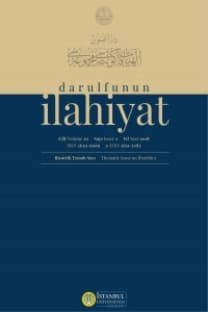Dirar B. Amr’in Kitabu’t-Tahrîş’ndeki Hadis Metodu
Dırar b. Amr’ın Kitabu’t-Tahrîş’i, İslamî fırkalar hakkında bilgi veren en eski kaynaklardan biridir. Kitap, hicri II.asırda fırkalar arasındaki polemiklerde kullanılan çok sayıda hadis rivayetini ihtiva etmektedir. Kitabın müellifi bu rivayetleri hangi metoda göre kullanmıştır? Kullanılan rivayetlerin sıhhat değeri nedir? Müellifih hadis kullanma metodunun hadisçilerin rivayet kurallarına uygunluğu açısından anlamı nedir? Elinizdeki çalışma bu soruların cevabından yola çıkarak müellifin hadis konusundaki yaklaşımını ortaya koymayı amaçlamaktadır. Çalışmamızda müellifin metodunun ortaya konulmasının yanı sıra kitapta yer alan rivayetler, kaynakları ve sıhhat durumları açısından tasnif edilerek bu konuda genel bir bilgi verilmeye çalışılmıştır. Kitapta bulunup da temel hadis kaynaklarında yer almayan rivayetlere ayrıca işaret edilmiştir. Çalışmamızda müellifinin rivayetleri kullanma metodunun zayıf olduğu, rivayetleri manayla aktararak hadisçilerin rivayet için belirlediği kurallara uyulmadığı, bu yüzden aslı sahih olan bir çok hadisin lafız ve mana değişikliğine uğradığı sonucuna varılmıştır.
Anahtar Kelimeler:
Dırar b. Amr, Kitabu’t-Tahriş, hadis tahrici, itikadi fırkalar, hadis eleştirisi, التحريش، ضرار بن عمرو، أهل القبلة، استغالل الحديث، نقد الحديث, التحريش, ضرار بن عمرو, نقد الحديث, استغالل الحديث, أهل القبلة
Dirar ibn Amr’s Understanding of Hadith in His Kitab al-Tahrish
Dirar ibn Amr’s book Kitab al-Tahrish is the oldest resource regarding the religious groups or factions. The book contains sources from the 2nd century AH and includes many hadith narrations these groups used as evidence to support their opinions against their opponents. In his book Ḍirar lists a given controversy and then provides the ḥadith of each faction cites to support their position regardless as it sound or fabricated. But what approach did the author of the book use when including these narrations? How accurately did he transmit the narrations in his book? Is there a similarity between the author’s uses of hadith and modernists’ understanding of hadith? This research seeks to answer these and other questions that are necessary to reveal the approach of the book and its author. After probing and classifying these texts, the book clearly is not including the same category of hadith in terms of accuracy. It contains sound, weak (i.e., incomplete sanad or with transmitters of questionable authority), and even fabricated narrations, some of which are not found in other sources. In addition, the author’s approach when referring to these narrations is considered inaccurate compared to the methods of modern sources and sometimes contains words that have been distorted from what is factual.
Keywords:
Kitab al-Tahrish, Dirar ibn Amr, accuracy of hadith, approach to hadith, criticism of hadith Dırar b. Amr, Kitabu’t-Tahriş, hadis tahrici, itikadi fırkalar, hadis eleştirisi, التحريش، ضرار بن عمرو، أهل القبلة، استغالل الحديث، نقد الحديث, التحريش, ضرار بن عمرو, نقد الحديث, استغالل الحديث, أهل القبلة,
___
- البلخي أبو القاسم عبد الله بن أحمد (ت 319هـ)، المقالات، تحقيق حسين خانصو وآخرون، الطبعة الثانية، 2020، دار الفتح، الأردن.
- ضرار بن عمرو الغطفاني، التحريش، تحقيق حسين خانصو ومحمد كسكين، الطبعة الأولى، 1435 هـ - 2014م، دار الإرشاد – تركيا، ودار ابن حزم – بيروت.
- Yayın Aralığı: Yılda 2 Sayı
- Başlangıç: 1925
- Yayıncı: İstanbul Üniversitesi İlahiyat Fakültesi
Sayıdaki Diğer Makaleler
Nurgül BULUT, Ahmet Celalettin GÜNEŞ, Hatice AYAR
Metin NOORATA, Önder KÜÇÜKURAL
The Image of Sulṭān in Islamic Mirror of Princes
Canlandırmayın (DNR) Talimatlarının İslam Hukukuna Göre Değerlendirilmesi
Jenny White’ın “Müslüman Milliyetçiliği ve Yeni Türkler” Adlı Eserinin Değerlendirilmesi
Dirar B. Amr’in Kitabu’t-Tahrîş’ndeki Hadis Metodu
İslam Hukuku Açısından Opsiyon Sözleşmeleri
İnsan- Hayvan İlişkisi Çerçevesinde Hayvan Refahı: Etik Açıdan Değerlendirme
